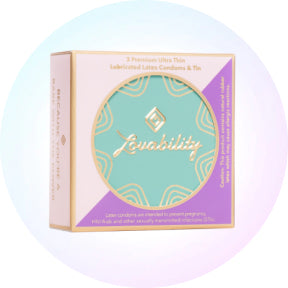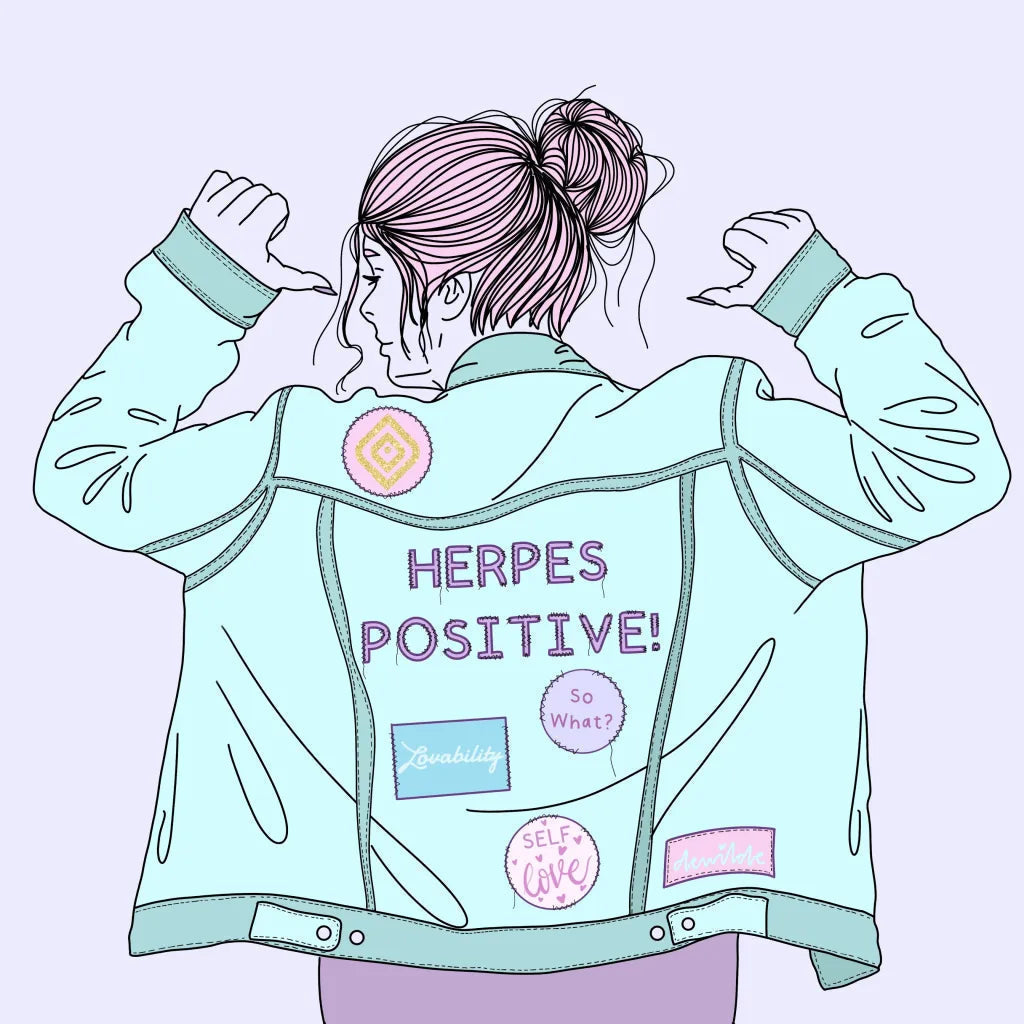A couple of years ago, I sat on my bedroom floor in tears. I had just been diagnosed with GHSV-1. What’s that, I hear you ask? Well, inquisitive reader, it’s herpes. Genital herpes, to be exact.
I asked my friend to come over and with a bottle of wine and takeout food, and I admitted how worthless and disgusting I felt. My friend picked up one of her chicken nuggets and threw it at my head. “You are NOT worthless,” she said. I felt slightly better. But the next morning, all I could feel was the weight of societal stigma and years of bad sex education pushing down on me. I couldn’t understand how I would ever feel comfortable or confident in my body again.
I Have Herpes. Now What Do I Do?
Before I explain how herpes helped me love my body again, I want to explain what I had to do to come to terms with the diagnosis and accompanying stigma. As a researching historian, my immediate impulse was to find out everything I could. I soon realized that coming to term with herpes meant understanding where the stigma came from, and the medical misinformation that had perpetuated it. I settled myself in front of my computer and began my journey.

Herpes: Explained
Before being diagnosed, I never noticed quite how frequently herpes is used in film and TV as a joke to describe something like a crazy ex-girlfriend because it will never go away. I remember the first time after my diagnosis that I heard this joke. I felt angry and embarrassed at such a cheap and thoughtless joke.
When I first began researching, I found out that herpes is actually part of the chicken pox family. It is in your nerve endings, lying dormant until something that lowers your immune system, like stress, triggers an outbreak of blisters on the surface of the skin – either on the mouth or genitals.
The herpes simplex virus (HSV) has two strains which affect the body differently. Strain 1 (HSV-1) causes cold sores on the mouth and is the more common type; a study in 2016 showed that it infected 67% of the population under 50 years old. HSV-1 passes through mouth-to-mouth contact but can also sometimes be spread to the genitals by engaging in oral sex.

Strain 2 (HSV-2) causes genital herpes and is transmitted via sexual intercourse. It is caused by skin-to-skin transmission instead of it being passed through fluids (like chlamydia). Neither strain of herpes can be prevented strictly through the use of a condom. This strain is more aggressive and has more frequent flare ups than HSV-1. It almost exclusively affects the genitals, but can be passed to the mouth and lips via oral sex.
I was shocked to find out that the majority of people who pass herpes on don’t even realize they have it themselves. So yes, once you have herpes, you’re in it for life. But the stigma surrounding herpes is only a recent development.
Herpes Shaming: A Brief Timeline
Quite simply, STIs / STDs are considered shameful because of years of sex-shaming, and conservative and religious ideals about sex. I felt a lot of these upon my diagnosis. Sex education at school taught me that to be clear from STDs was to be ‘clean’ from them. So did that mean that I was dirty? Was it karmic punishment for enjoying casual sex? I couldn’t help but feel like the body I spent years deciding to love had betrayed me.
My favorite fact is that herpes is actually one of the oldest sexually transmitted diseases. It has been a part of human history since the moment we evolved from primates.
Even Shakespeare referenced the virus in Romeo and Juliet, writing about blisters on women’s lips. Until the 1970s, however, herpes was just a regular skin condition which flared up and went away on its own. In 1973, Time Magazine claimed that genital herpes seemed to only infect those who were sexually promiscuous.

A lot of this information left me confused. I struggled to understand just how herpes had gone from a primeval nuisance to a 1970s public health crisis. There seemed to be such a wealth of misunderstanding and stigma that came out of nowhere. This was when I uncovered that pharmaceuticals realized that by developing anti-virals, they could profit from herpes.
In 1982, Acyclovir was developed to treat genital herpes. This further fed into the narrative that herpes was something which needed to be treated and cured. Fact is, the treatment only increases healing time and decreases the risk of transmission. There is nothing to cure. This added to the shame around the condition in the same way that the patriarchy have shamed women out of growing body hair by marketing ‘female razors’. It all added up.
In the same year, TIME released a cover that heralded herpes as ‘The New Scarlet Letter’. It reported horror stories from victims and doctors, and shamed sex workers and the men who frequented them with the incurability factor exacerbated to scare people into leading a ‘moral’ life. Herpes was the punishment for the sexual revolution. This stoked the public’s anxieties about herpes which could seemingly strike at any time.
Learning To Love Myself With Herpes
After all this research, I was left overwhelmed. Even though I had started to dismantle the stigma and misinformation, I was still a little scared. There weren’t many recent articles which promoted a positive message for anyone newly diagnosed. I always promoted body and sex positivity to my friends, but my diagnosis made me so repulsed by my own body that I couldn’t even bring myself to masturbate.
How was I supposed to preach positivity and pleasure when I couldn’t feel that way about myself?
After I tackled the history of the stigma, I researched how to care for myself. I found out that flare-ups are usually caused by stress and a lack of sleep. So I started to manage my stress in a healthier way and consciously reclaimed my sleep pattern. I drank water, took my antivirals, and soon my blisters scabbed over and I could stop dreading going to pee.

But falling back in love with my body didn’t just come from nursing myself back to health. I knew it began somewhere deeper and steeped with stigma. The mentality of feeling ‘dirty’ because I had an STD was something I had to unlearn. I had to effectively break up with myself and everything that had been instilled in me by society. I spent a lot of time reading about herpes and immersing myself in feminist material to empower me when I felt I couldn’t do it myself. I learned that my self-worth was not tied to an STD or to my sex life.
Herpes helped me love my body by opening up a new relationship with sex and how I allowed other people to make me feel.
I used to dread telling new potential partners that I had herpes. It had usually been a difficult conversation that ended in rejection. I found myself trying to convince them that I wasn’t a hazard. I took a painful lesson from this – I should never have to convince someone to sleep with me. I was still me – nothing had actually changed other than I knew something new about my body. My body hadn’t betrayed me by breaking out in a virus that had likely been in my system for years already. It was protecting me. I stopped punishing myself for something which was so wildly out of my control.
A Love Letter To Ourselves
If you’re reading this after a new diagnosis or an old one you’re still processing, then this is my love-letter to you as much as it is to myself. Our bodies are strong and powerful. There is nothing wrong with us. Learning about the medical side and stigma is important, but the real work is what we do with the facts. The road to self-love is never an easy one, but I love and respect my body in a new way that I couldn’t do before I was diagnosed.
I don’t love my body because of an STD. I love my body despite having an STD.
Extra Reading
If you’re curious to find out more about herpes, here are some great places to start: The World Health Organization, ‘Herpes Simplex Virus’, Herpes Virus Association, (UK based but has great information), and American Sexual Health Association. I also recommend the work of Ella Dawson because she was the best help for me at the beginning.
Another valuable resource to check out is the STI Project led by Jenelle Marie Pierce; their platform provides an abundance of information (data, testing resources, prevention, etc.) as well as empowering content.
If you’re interested in following up on the resources in this article, take a look at TIME Magazine, ‘The New Scarlett Letter’ and TIME Magazine, ‘The Case Against Herpes’.
About The Author
Based in the UK, Darcy (@dxrcyer on Instagram) is a BA and Master’s by Research graduate in History specialising in medical history. Her work focuses on violence on the body, the evolution of public views on anatomy, and corporeal metaphors through time. This also includes the presentation of the female body and the expectations of female dignity before public execution. Darcy is also a self-taught digital illustrator and this fascination with anatomy is also found in her work which combines messages of body positivity and female empowerment.












